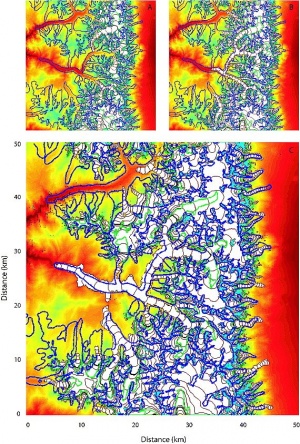Model:Gc2d: Difference between revisions
m (add model) |
m (Text replacement - "{{End headertab}}" to "{{End headertab}} {{{{PAGENAME}}_autokeywords}}") |
||
| (65 intermediate revisions by 4 users not shown) | |||
| Line 1: | Line 1: | ||
{{ | {{Model identity | ||
| | |Model type=Single | ||
}} | }} | ||
{{Start models incorporated}} | |||
{{End a table}} | |||
{{Model identity2 | |||
|ModelDomain=Terrestrial, Cryosphere | |||
|Spatial dimensions=2D | |||
|One-line model description=Glacier / ice sheet evolution model | |||
|Extended model description=Models the growth and evolution of valley glaciers and ice sheets | |||
}} | |||
{{Start model keyword table}} | |||
{{Model keywords | |||
|Model keywords=cryosphere | |||
}} | |||
{{End a table}} | |||
{{Modeler information | |||
|First name=Mark | |||
|Last name=Kessler | |||
|Type of contact=Model developer | |||
|Institute / Organization=University of Colorado | |||
|Postal address 1=1560 30th street | |||
|Town / City=Boulder | |||
|Postal code=80305 | |||
|Country=United States | |||
|State=Colorado | |||
|Email address=mark.kessler@colorado.edu | |||
}} | |||
{{Additional modeler information | |||
|Additional first name=Eric | |||
|Additional last name=Hutton | |||
|Additional type of contact=Technical contact | |||
|Additional institute / Organization=CSDMS, INSTAAR, University of Colorado | |||
|Additional postal address 1=1560 30th street | |||
|Additional town / City=Boulder | |||
|Additional postal code=80305 | |||
|Additional country=United States | |||
|Additional state=Colorado | |||
|Additional email address=huttone@colorado.edu | |||
}} | |||
{{Model technical information | |||
|Supported platforms=Unix, Linux, Mac OS, Windows | |||
|Programming language=Python, Matlab | |||
|Code optimized=Single Processor | |||
|Start year development=2005 | |||
|Does model development still take place?=Yes | |||
|Model availability=As code | |||
|Source code availability=Through CSDMS repository | |||
|Source csdms web address=https://github.com/csdms-contrib/gc2d | |||
|Program license type=Apache public license | |||
|Memory requirements=Minimal | |||
|Typical run time=hours | |||
}} | |||
{{Input - Output description | |||
|Describe input parameters=Landscape elevation, ELA with time | |||
|Other input format=Matlab .mat files | |||
|Describe output parameters=Glacier thickness and elevation | |||
|Other output format=Matlab .mat files | |||
|Pre-processing software needed?=No | |||
|Post-processing software needed?=No | |||
|Visualization software needed?=No | |||
}} | |||
{{Process description model | |||
|Describe processes represented by the model=Glacier growth and evolution | |||
|Describe length scale and resolution constraints=kilometers | |||
|Describe time scale and resolution constraints=Tens to hundreds of years | |||
}} | |||
{{Model testing}} | |||
{{Users groups model | |||
|Do you have current or future plans for collaborating with other researchers?=None | |||
}} | |||
{{Documentation model | |||
|Manual model available=No | |||
|Model website if any=[http://dx.doi.org/10.1130%2F0091-7613%282000%2928%3C1031%3ANSOGLP%3E2.0.CO%3B2] | |||
}} | |||
{{Additional comments model}} | |||
{{CSDMS staff part | |||
|OpenMI compliant=No but possible | |||
|IRF interface=Yes | |||
|CMT component=No but possible | |||
|CCA component=Yes | |||
}} | |||
{{Start coupled table}} | |||
{{CSDMS coupled models | |||
|Animation model name=TopoFlow | |||
}} | |||
{{CSDMS coupled models | |||
|Animation model name=TopoFlow-Snowmelt-Degree-Day | |||
}} | |||
{{CSDMS coupled models | |||
|Animation model name=TopoFlow-Snowmelt-Energy Balance | |||
}} | |||
{{CSDMS coupled models | |||
|Animation model name=TopoFlow-Meteorology | |||
}} | |||
{{End a table}} | |||
{{End headertab}} | |||
{{{{PAGENAME}}_autokeywords}} | |||
<!-- Edit the part above to update info on other papers --> | <!-- Edit the part above to update info on other papers --> | ||
==Introduction== | |||
[[image:gc2d.jpg| border|right|300px ]] | [[image:gc2d.jpg| border|right|300px ]] | ||
''gc2d'' a two-dimensional finite difference numerical model that simulates the formation and evolution of temperate valley glaciers on a two-dimensional topographic surface with a specified meteorological setting. Driven by a time series of mass balance (snow precipitation - melt rate), the model calculates ice surface elevations above a two-dimensional terrain by solving equations for ice flux and mass conservation using explicit methods. A number of other authors have employed one- and two-dimensional models based on similar sets of equations. However, ''gc2d'' integrates glacier and climate simulation components explicitly, and thus has the unique ability to simulate feedbacks between the changing ice surface and the climate forcing. In addition, the framework of this model permits the inclusion of discrete processes that modify the ice distribution, such as avalanching on steep terrain. The efficiency of this model allows simulation of glacial evolution over millennial timescales at spatial scales that resolve valley glaciers. Finally, from a computational standpoint, the simplicity of this model permits the investigation of significant regions of parameter space, allowing us to determine the effect of new processes or altered algorithms for them. | ''gc2d'' a two-dimensional finite difference numerical model that simulates the formation and evolution of temperate valley glaciers on a two-dimensional topographic surface with a specified meteorological setting. Driven by a time series of mass balance (snow precipitation - melt rate), the model calculates ice surface elevations above a two-dimensional terrain by solving equations for ice flux and mass conservation using explicit methods. A number of other authors have employed one- and two-dimensional models based on similar sets of equations. However, ''gc2d'' integrates glacier and climate simulation components explicitly, and thus has the unique ability to simulate feedbacks between the changing ice surface and the climate forcing. In addition, the framework of this model permits the inclusion of discrete processes that modify the ice distribution, such as avalanching on steep terrain. The efficiency of this model allows simulation of glacial evolution over millennial timescales at spatial scales that resolve valley glaciers. Finally, from a computational standpoint, the simplicity of this model permits the investigation of significant regions of parameter space, allowing us to determine the effect of new processes or altered algorithms for them. | ||
The above description is taken almost verbatim from Kessler et al. (2006) | The above description is taken almost verbatim from Kessler et al. (2006). | ||
== References == | |||
<br>{{AddReferenceUploadButtons}}<br><br> | |||
{{#ifexist:Template:{{PAGENAME}}-citation-indices|{{{{PAGENAME}}-citation-indices}}|}}<br> | |||
{{Include_featured_references_models_cargo}}<br> | |||
== History == | |||
== | == Issues == | ||
== Help == | |||
{{#ifexist:Model_help:{{PAGENAME}}|[[Model_help:{{PAGENAME}}]]|}} | |||
== Input Files == | |||
== Output Files == | |||
Latest revision as of 20:14, 16 September 2020
Gc2d
Metadata
|
|
|
Introduction
gc2d a two-dimensional finite difference numerical model that simulates the formation and evolution of temperate valley glaciers on a two-dimensional topographic surface with a specified meteorological setting. Driven by a time series of mass balance (snow precipitation - melt rate), the model calculates ice surface elevations above a two-dimensional terrain by solving equations for ice flux and mass conservation using explicit methods. A number of other authors have employed one- and two-dimensional models based on similar sets of equations. However, gc2d integrates glacier and climate simulation components explicitly, and thus has the unique ability to simulate feedbacks between the changing ice surface and the climate forcing. In addition, the framework of this model permits the inclusion of discrete processes that modify the ice distribution, such as avalanching on steep terrain. The efficiency of this model allows simulation of glacial evolution over millennial timescales at spatial scales that resolve valley glaciers. Finally, from a computational standpoint, the simplicity of this model permits the investigation of significant regions of parameter space, allowing us to determine the effect of new processes or altered algorithms for them.
The above description is taken almost verbatim from Kessler et al. (2006).
References
| Nr. of publications: | 4 |
| Total citations: | 455 |
| h-index: | 4 |
| m-quotient: | 0.17 |
| Featured publication(s) | Year | Model described | Type of Reference | Citations |
|---|---|---|---|---|
|
MacGregor, K.R.; Anderson, R.S.; Anderson, S.P.; Waddington, E.D.; 2000. Numerical Simulations of Glacial-Valley Longitudinal Profile Evolution.. Geology, 28, 1031-1034. <1031:NSOGLP>2.0.CO;2 10.1130/0091-7613(2000)28<1031:NSOGLP>2.0.CO;2 (View/edit entry) | 2000 | Gc2d |
Model overview | 192 |
| See more publications of Gc2d |


